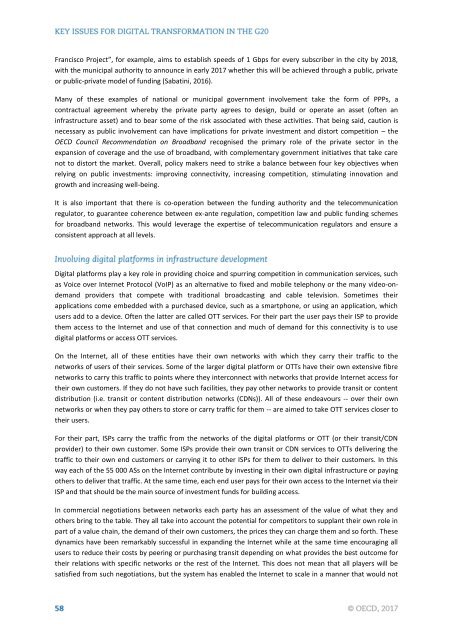KEY ISSUES FOR DIGITAL TRANSFORMATION IN THE G20
2jz0oUm
2jz0oUm
You also want an ePaper? Increase the reach of your titles
YUMPU automatically turns print PDFs into web optimized ePapers that Google loves.
Francisco Project”, for example, aims to establish speeds of 1 Gbps for every subscriber in the city by 2018,<br />
with the municipal authority to announce in early 2017 whether this will be achieved through a public, private<br />
or public-private model of funding (Sabatini, 2016).<br />
Many of these examples of national or municipal government involvement take the form of PPPs, a<br />
contractual agreement whereby the private party agrees to design, build or operate an asset (often an<br />
infrastructure asset) and to bear some of the risk associated with these activities. That being said, caution is<br />
necessary as public involvement can have implications for private investment and distort competition – the<br />
OECD Council Recommendation on Broadband recognised the primary role of the private sector in the<br />
expansion of coverage and the use of broadband, with complementary government initiatives that take care<br />
not to distort the market. Overall, policy makers need to strike a balance between four key objectives when<br />
relying on public investments: improving connectivity, increasing competition, stimulating innovation and<br />
growth and increasing well-being.<br />
It is also important that there is co-operation between the funding authority and the telecommunication<br />
regulator, to guarantee coherence between ex-ante regulation, competition law and public funding schemes<br />
for broadband networks. This would leverage the expertise of telecommunication regulators and ensure a<br />
consistent approach at all levels.<br />
Digital platforms play a key role in providing choice and spurring competition in communication services, such<br />
as Voice over Internet Protocol (VoIP) as an alternative to fixed and mobile telephony or the many video-ondemand<br />
providers that compete with traditional broadcasting and cable television. Sometimes their<br />
applications come embedded with a purchased device, such as a smartphone, or using an application, which<br />
users add to a device. Often the latter are called OTT services. For their part the user pays their ISP to provide<br />
them access to the Internet and use of that connection and much of demand for this connectivity is to use<br />
digital platforms or access OTT services.<br />
On the Internet, all of these entities have their own networks with which they carry their traffic to the<br />
networks of users of their services. Some of the larger digital platform or OTTs have their own extensive fibre<br />
networks to carry this traffic to points where they interconnect with networks that provide Internet access for<br />
their own customers. If they do not have such facilities, they pay other networks to provide transit or content<br />
distribution (i.e. transit or content distribution networks (CDNs)). All of these endeavours -- over their own<br />
networks or when they pay others to store or carry traffic for them -- are aimed to take OTT services closer to<br />
their users.<br />
For their part, ISPs carry the traffic from the networks of the digital platforms or OTT (or their transit/CDN<br />
provider) to their own customer. Some ISPs provide their own transit or CDN services to OTTs delivering the<br />
traffic to their own end customers or carrying it to other ISPs for them to deliver to their customers. In this<br />
way each of the 55 000 ASs on the Internet contribute by investing in their own digital infrastructure or paying<br />
others to deliver that traffic. At the same time, each end user pays for their own access to the Internet via their<br />
ISP and that should be the main source of investment funds for building access.<br />
In commercial negotiations between networks each party has an assessment of the value of what they and<br />
others bring to the table. They all take into account the potential for competitors to supplant their own role in<br />
part of a value chain, the demand of their own customers, the prices they can charge them and so forth. These<br />
dynamics have been remarkably successful in expanding the Internet while at the same time encouraging all<br />
users to reduce their costs by peering or purchasing transit depending on what provides the best outcome for<br />
their relations with specific networks or the rest of the Internet. This does not mean that all players will be<br />
satisfied from such negotiations, but the system has enabled the Internet to scale in a manner that would not


